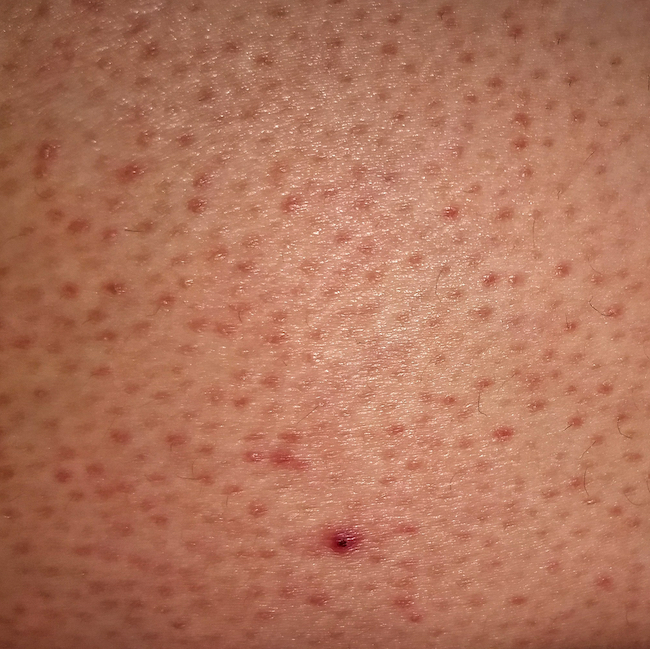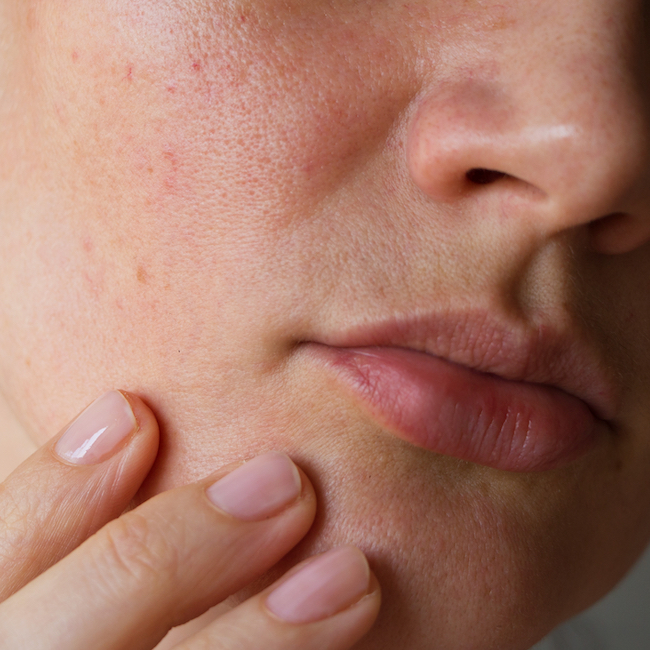
Keratosis Pilaris, or “KP” for short, is a skin condition that manifests as tiny, rough bumps on the surface of the skin. It most commonly appears on the backs of arms, thighs, cheeks, and buttocks, and is generally harmless. However, it can be incredibly frustrating, especially because it’s hard to treat. “The latest research shows that skin with KP lacks sebaceous glands, which secrete oils, fats, and acids that help promote healthy hair follicle growth and skin turnover,” says Dr. Anar Mikailov, MD, a board-certified dermatologist and Founder of KP Away, a line of skincare products targeted towards KP-prone skin. When there aren’t enough sebaceous glands on the skin, that leads to follicles being plugged, which causes the dry bumps and redness you see on your skin. While the cause of this isn’t entirely clear, KP can be spurred on by certain medicines or inherited through genetics. In particular, KP is often seen more in families with a history of inflammatory conditions like asthma.
If you’re like me, you’ve tried every body wash, exfoliant, and strange diet under the sun to try and get your KP to go away. It may be easy to want to exfoliate away to try and reduce the bumpiness, but according to Dr. Mikailov, it’s best to keep your treatment plan simple and gentle. “The best way to treat KP is to treat it as very sensitive, irritated skin that requires a lot of gentle nourishment,” he says, “Instead of reaching for a moisturizer with harsh exfoliating acids, which do help relieve the skin of bumps, it's more important to focus on restoring natural lipids and water density in the skin.”
To get to the root cause of your KP, you need a skincare routine that is gentle but effective, “Look for a moisturizer with fewer than 10 ingredients and has a high percentage of coconut oil, wax, and water. The fewer ingredients usually mean the less potentially irritating it can be,” Dr, Mikailov says.
Although too much exfoliation can be harmful, exfoliating in moderation can actually be good for KP. But, Dr, Mikailov says there are a few things you should keep in mind. “Avoid any harsh scrubs, moisturizers, serums, and high percentages of AHAs, BHAs, PHAs, or urea.” Also, you should avoid BHAs, or Beta Hydroxy Acids. BHAs are harsh types of carboxylic acids that work deep under the skin to kill bacteria. One of the most common BHAs is salyclic acid, which is used in many acne skincare treatments on the market. You may think it will help your skin, but it may actually do the opposite. “BHAs work to help control excess sebum production, which is the opposite of KP. If you choose an exfoliator, look for a gentle, very mild physical scrub in a hydrating, cream formula.”
If you have KP, it may be easy to want to treat it like acne. However, KP works very differently than KP, and if you treat it like you would acne, it may make the condition worse. Focus on gentle, cream based products with simple ingredients that aren’t too harsh. It can be frustrating and feel like nothing works, but consistency is key. Sticking with a routine that works for your skin is the key to reducing KP. If your skin becomes irritated enough that it causes physical discomfort, consult with a dermatologist about a skincare plan that is uniquely formulated to your skin’s chemistry.


